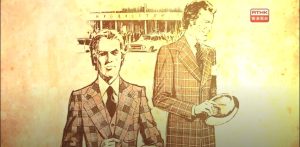Today we are introducing an article ‘Identity pride and exclusiveness: cross-border craftsmanship and Chinese tailors in post-war Hong Kong, 1945-1970’ by Katon Lee.
The tailoring industry is one of the traditional trades in Hong Kong, and “Shanghai tailoring” is one of its distinctive skills, attracting people from around the world to patronize. There is a story behind it.
Prior to the 1970s, Hong Kong was a migrant society. Due to political turmoil in China and significant discrepancies in living standards and economic opportunities, the city received a large influx of mainland Chinese immigrants in the post-war era. In the first wave of Chinese mass migration, which took place from the mid-1940s through to the 1950s, tens of thousands of Chinese tailors migrated to Hong Kong from Canton and Shanghai in search of political stability and personal safety. Thanks to their tailoring expertise and work experience, they began to develop a professional reputation in local society, earning themselves worldwide recognition as their suits emerged as one of the most representative cultural icons of the city in the eyes of many Western visitors. While some Chinese elites and businessmen would order suits from Cantonese and Shanghainese tailors for the purpose of dressing for work and social gatherings, the tailors’ target customers were predominantly Western tourists who demanded suits for everyday use and were better able to pay for them.
The Kung Sheung Evening News conducted some brief surveys that shed light on the tailoring landscape in early post-war Hong Kong. As noted in its article on 18 November 1946, at the onset of the migration wave, approximately 700 Chinese tailors fled from Mainland China and set up their establishments in the tailoring industry in 1946. After 1949, the CCP considered suits to be an ‘evil symbol’ of western capitalism, and suit businesses were quickly abandoned. More suit-making tailors, who were vilified as ‘capitalist roaders’, felt insecure living under communist control and decided to flee from Canton and Shanghai to Hong Kong due to its protection from communist governance. In this wave of post-war migration, most of the Chinese tailors migrating to the city were from Canton while only a small minority were from Shanghai. This pattern is the result of the now-strict immigration policies imposed by the colonial government in the 1950s to replace the lax controls. These measures required that all people who sought to enter the city by land from ports north of Guangdong must hold a Hong Kong entry permit. While non-Cantonese needed to obtain the permits either from the Office of the Charge d’Affaires in Beijing or through relatives in Hong Kong, Cantonese from Guangdong were exempt from this requirement. Under these stricter immigration controls, the proportion of Shanghainese tailors quickly dropped, becoming a distinct minority in the industry. However, they brought sophisticated industrial practices that oral history interviewees termed ‘a significant threat’ to their Cantonese counterparts.
With a long tradition of providing suit-making and tailoring services for Westerners, Shanghainese tailors enjoyed widespread fame in the suit market. Because they hailed from Shanghai, where Chinese and Western cultural and commercial interactions had long flourished – and where they acquired a form of cultural capital associated with what historian Leo Lee has termed ‘Shanghai modernity’ – Hong Kong’s Shanghainese tailors were able to best their Cantonese competitors in marketing high-end suits.
Recent scholarship has shown that in cosmopolitan urban spaces, identities are flexible, and migrants often integrate smoothly. But Shanghainese and Cantonese tailors who migrated to Hong Kong after World War II developed a different trajectory of identity transformation. Instead of simply integrating into a single social collectivity based on claims to a common Chinese ethnicity, they forged separate diasporic identities according to their places of origin. By problematising the arrival of Shanghainese tailors and their interactions with Cantonese tailors in Hong Kong, this article shows that pride in a place-based identity along with a strong sense of exclusiveness facilitated the maintenance of social boundaries by the Shanghainese community against the Cantonese. It argues that despite the common Chinese-ness of both migrant communities, place of origin was employed as a critical form of social identification and differentiation, creating an as-yet insurmountable barrier to the amalgamation of the two Chinese communities.
裁縫業是香港傳統行業之一,而「 上海裁縫 」是其特色技藝之一,吸引不少人從世界各地而來光顧,背後有段故事。
1970年代前,香港是個移民社會。由於中國的政治動盪和生活水平以及經濟機會的顯著差異,在二戰後時期,這個城市迎來大量中國大陸移民。從1940年代中期到1950年代第一波中國大規模移民裏,數以萬計的中國裁縫從廣州和上海移民到香港,尋求政治穩定和個人安全。憑藉他們的裁縫技術和工作經驗,他們在當地社會建立了專業聲譽,繼而蜚聲國際,他們的西裝成為許多西方遊客眼中這座城市最具代表性的文化符號之一。雖然一些中國菁英和商人會訂製來自廣東和上海裁縫的西裝,以在工作和社交場合穿著,但裁縫們的目標客戶主要是日常使用西裝的西方遊客,他們更有能力消費。
《工商晚報》進行的一些簡短調查,闡明了戰後初期香港裁縫業的情況。正如該報1946年11月18日的文章所述,在移民潮開始時,大約有700名中國裁縫師從中國大陸逃離,於1946年在香港設立了他們的工作室。1949年後,中共視西裝為西方資本主義的「邪惡象徵」,西裝業務迅速被停止。愈來愈多西裝裁縫被詆毀成「走資派」,他們對於在共產黨控制下生活感到不安,決定從廣東和上海逃往香港以免受到威脅。在這波戰後移民潮中,大多數移民到香港的中國裁縫師來自廣東,而只有少數來自上海。這種模式是上世紀50年代殖民政府從寬鬆控制轉而實施嚴格入境政策的結果。這些措施要求所有從廣東以北港口陸路進入城市的人必須持有香港入境許可證。而非廣東人需要從駐北京代辦處或通過在香港的親戚獲得許可證,廣東省內的廣東人則免除這要求。在這些更嚴格的移民控制下,在港上海裁縫師的比例迅速下降,成為該行業中的顯著少數。然而,他們的精湛工藝為來自廣東的同行帶來了口述歷史受訪者所講的「重大威脅」。
擁有為西方人製作西裝和提供裁縫服務的悠久傳統,上海裁縫在西裝市場上享有廣泛聲譽。由於他們來自上海,在那裡中西文化和商業交流長期繁榮——他們獲得了被歷史學家Leo Lee稱之為「上海現代性」的一種文化資本——香港的上海裁縫能夠在高端西裝市場上超越他們的廣東競爭對手。
近期的研究表明,在國際化的城市空間中,身份是靈活的,移民往往能夠順利融入。但在二戰後移民到香港的上海和廣東裁縫卻發展出不同的身份轉變軌跡。他們並非僅僅融入到一個基於共同中國族裔的社會集體中,而是根據自己的來源地鍛造了獨立的離散身份。通過對上海裁縫的遷移以及他們與廣東裁縫在香港的互動深入研究,本文顯示了基於地方身份的自豪感和強烈的排他性有助於上海與廣東社群之間的社會區隔。本文認為,儘管這兩個移民社群都具有共同的中國特性,但出身地被用作一種重要的社會識別和差異形式,從而在兩個中國社群的融合上創造了一道尚未跨越的障礙。
香港故事 – 世紀物語 (第51輯)
https://podcast.rthk.hk/podcast/item.php?pid=1976&eid=193161&year=2021


